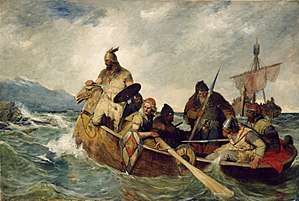815
Year 815 (DCCCXV) was a common year starting on Monday (link will display the full calendar) of the Julian calendar.
| Millennium: | 1st millennium |
|---|---|
| Centuries: | |
| Decades: | |
| Years: |
|
| 815 by topic |
|---|
| Leaders |
| Categories |
|
| Gregorian calendar | 815 DCCCXV |
| Ab urbe condita | 1568 |
| Armenian calendar | 264 ԹՎ ՄԿԴ |
| Assyrian calendar | 5565 |
| Balinese saka calendar | 736–737 |
| Bengali calendar | 222 |
| Berber calendar | 1765 |
| Buddhist calendar | 1359 |
| Burmese calendar | 177 |
| Byzantine calendar | 6323–6324 |
| Chinese calendar | 甲午年 (Wood Horse) 3511 or 3451 — to — 乙未年 (Wood Goat) 3512 or 3452 |
| Coptic calendar | 531–532 |
| Discordian calendar | 1981 |
| Ethiopian calendar | 807–808 |
| Hebrew calendar | 4575–4576 |
| Hindu calendars | |
| - Vikram Samvat | 871–872 |
| - Shaka Samvat | 736–737 |
| - Kali Yuga | 3915–3916 |
| Holocene calendar | 10815 |
| Iranian calendar | 193–194 |
| Islamic calendar | 199–200 |
| Japanese calendar | Kōnin 6 (弘仁6年) |
| Javanese calendar | 711–712 |
| Julian calendar | 815 DCCCXV |
| Korean calendar | 3148 |
| Minguo calendar | 1097 before ROC 民前1097年 |
| Nanakshahi calendar | −653 |
| Seleucid era | 1126/1127 AG |
| Thai solar calendar | 1357–1358 |
| Tibetan calendar | 阳木马年 (male Wood-Horse) 941 or 560 or −212 — to — 阴木羊年 (female Wood-Goat) 942 or 561 or −211 |

Map indicating travels of first Scandinavians
Events
By place
Byzantine Empire
- Byzantine–Bulgarian Treaty: Emperor Leo V the Armenian signs a 30-year peace agreement in Constantinople with Omurtag, ruler (khan) of the Bulgarian Empire. The Rhodope Mountains become the Byzantine border again, and Leo regains its lost Black Sea cities, after the Bulgars have them demolished.[1]
Europe
- Hrafna-Flóki Vilgerðarson sets out from the Faroe Islands and discovers Iceland (documented later in the Landnámabók) (approximate date).
Britain
Asia
By topic
Religion
- Synod of Constantinople: A council led by patriarch Theodotus I, in the Hagia Sophia, reinstitutes iconoclasm.[3]
Births
- Abu Hanifa Dinawari, Muslim botanist and geographer (d. 896)
- Boniface VI, pope of the Catholic Church (d. 896)
- Dawud al-Zahiri, Muslim scholar (approximate date)
- Eberhard, duke of Friuli (approximate date)
- Johannes Scotus Eriugena, Irish theologian (approximate date)
- Leoluca, Sicilian abbot (approximate date)
- Methodius, Byzantine missionary and bishop (d. 885)
- Theodora, Byzantine empress (approximate date)
Deaths
- July 13 – Wu Yuanheng, chancellor of the Tang Dynasty (b. 758)
- Jābir ibn Hayyān (Geber), Muslim alchemist (approximate date)
- Laylā bint Ṭarīf, Arab woman warrior poet
- Mashallah ibn Athari, Jewish-Arab astrologer
- Muirgius mac Tommaltaig, king of Connacht (Ireland)
- Omar Tiberiades, Persian astrologer (approximate date)
- Sadnalegs, emperor of Tibet (approximate date)
gollark: 2207.
gollark: ++remind 14h apio form
gollark: No.
gollark: We could automate this with shell scripting, SO's API (I assume it has one) and `jq`!
gollark: And yet.
References
- Fine, John V. A., Jr. (1991) [1983]. The Early Medieval Balkans: A Critical Survey from the Sixth to the Late Twelfth Century. Ann Arbor, Michigan: University of Michigan Press. p. 106. ISBN 0-472-08149-7.
- Swanton, Anglo-Saxon Chronicle, pp. 58–59.
- Kazhdan, Alexander, ed. (1991). The Oxford Dictionary of Byzantium. Oxford and New York: Oxford University Press. pp. 513–514. ISBN 0-19-504652-8.
This article is issued from Wikipedia. The text is licensed under Creative Commons - Attribution - Sharealike. Additional terms may apply for the media files.
